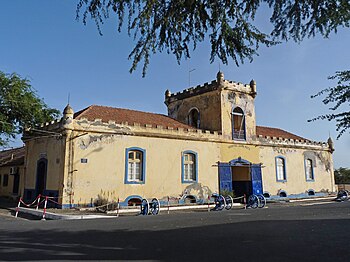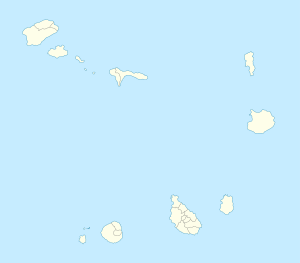Quartel Jaime Mota
| Quartel Jaime Mota | |
|---|---|
| Av. Andrade Corvo Praia, Cape Verde |
|

Front of the barracks of Jaime Mota
|
|
|
Cape Verde
|
|
| Coordinates | 14°55′54″N 23°30′30″W / 14.93167°N 23.50833°WCoordinates: 14°55′54″N 23°30′30″W / 14.93167°N 23.50833°W |
| Site history | |
| Built | 1826 |
Quartel Jaime Mota is a former military barrack located on the southern end of Avenida Andrade Corvo in Praia, Cape Verde, on the highest part of the historic area of the plateau (Platô). Located next to Palácio Presidencial to its west, monuments including one dedicated to Diogo Gomes in the west and to Praça Alexandre Albuquerque which features two monuments including one of Serpa Pinto, it overlooks the Atlantic along with its beach, Gambôa, the city's port and harbor. It was built in 1826 with colonial style architecture and one of the oldest in the city, below is the roundabout that intersects with the shoreline road.
Its modern name is named after Jaime Mota, a Cape Verdean guerilla, militant of PAICV who was killed in Portuguese Guinea (now Guinea-Bissau).
In the building's front, four former cannon wheels colored blue is featured along with its façade and white window panels.
After the Cassard expedition in 1712 which destroyed all of Cidade Velha (then as Ribeira Grande), the island and colonial capital was moved to Praia, Praia was not officially the capital until 1770. The earlier barracks would be built along with the cannons in the eastern portion, cannons were put and its defenses extended up to 250 meters (then 750 feet) from the barracks and are alongside two streets, one now called Neves Ferreira and the other now called Tenente Valdim. Its defenses protected the city from further pirate attacks until the mid 19th century. The military barracks would be built in 1826.
The change of a part of the barrack to a national museum started planning in 2004. The project was started in 2012, the building will house both services of the Ministry of Defense and the military museum. The work takes in the need to preserve a historic façade and the original structure of in a horseshoe form, describes Portuguese forts of the 19th century. A street is now used as a walkway today.
...
Wikipedia

